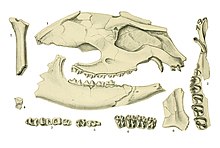| Epihippus Temporal range: 46.2–38.0 Ma PreꞒ Ꞓ O S D C P T J K Pg N Early Uintan to Duchesnean | |
|---|---|

| |
| Illustration of Epihippus gracilis skull and teeth | |
| Scientific classification | |
| Domain: | Eukaryota |
| Kingdom: | Animalia |
| Phylum: | Chordata |
| Class: | Mammalia |
| Order: | Perissodactyla |
| Family: | Equidae |
| Genus: | †Epihippus Marsh, 1877 |
| Synonyms | |
| |
Epihippus is an extinct genus of the modern horse family Equidae that lived in the Eocene, from 46 to 38 million years ago.

Epihippus is believed to have evolved from Orohippus, which continued the evolutionary trend of increasingly efficient grinding teeth. It had five grinding, low-crowned cheek teeth with well-formed crests. A late and partially recognized species of Epihippus, sometimes called Duchesnehippus intermedius, had teeth similar to Oligocene equids, although slightly less developed. The genus fed mostly on insects, berries and plant material.
Species
There are three species:
- Epihippus gracilis
- Epihippus intermedius
- Epihippus uintensis
References
- ^ "Fossilworks: Epihippus". paleodb.org. Retrieved 8 May 2017.
- "Mindat.org". www.mindat.org. Retrieved 2022-10-02.
- "Fossilworks: Epihippus (Duchesnehippus)". Paleobiology Database. Retrieved 2022-10-02.
| Extinct genera of Equidae (Horse family), arranged by subfamily | |||||||||
|---|---|---|---|---|---|---|---|---|---|
| |||||||||
| Basal forms | |||||||||
| Anchitheriinae | |||||||||
| Equinae |
| ||||||||
| Taxon identifiers | |
|---|---|
| Epihippus | |
This prehistoric odd-toed ungulate-related article is a stub. You can help Misplaced Pages by expanding it. |








